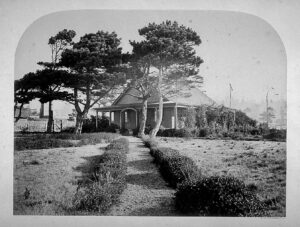
Not long after Mendocino was founded, the men who built and owned the Big River sawmill went back east to New England and brought their families here to live. While many of the merchants in town resided above their stores, the people associated with running the mill constructed their houses on the south side of Main Street on land that was owned by the Mendocino Lumber Mill Company. These were the Kelley family’s across-the-street neighbors.
There were four Company homes – all attractive cottages that resembled structures back in their hometowns, decorated with barge board trim and with porches for appreciating the spectacular views of Mendocino Bay. Each had smaller buildings associated with them – sheds, barns, water tanks, outhouses, and fences everywhere. My, they liked those picket fences!
Only one of these structures is still standing – the Ford House – which today functions as an interpretive visitor’s center for the Mendocino Headlands State Park. Built in 1854, Jerome brought his new bride, Martha Hayes, to this tidy cottage and lived there with their large family until 1872, when they decamped for Oakland. A few years later, their oldest son, Chester, returned to his home place to run the mill, and other superintendents and their families continued to reside there until the mill closed in the 1930s.
Westward of the Ford House (opposite Dick’s Place) was the Presbyterian Church Parsonage, set back from the street and reached through a tidy gate in a white picket fence on Main Street. While we have no clear images of it, we see it peeking from the edges of vintage photos and depicted on old maps. This quote comes from an editorial in the February 1862 edition of The Pacific: “The Presbyterian Church in Mendocino has . . . built the minister a fine parsonage, a commodious study, and have liberally overpaid his salary.”
Alas, in 1901 a kitchen stove fire entirely destroyed the structure along with the Rev. Tyndall family’s belongings. A few years later, a new parsonage was erected right next to the Church and is known today as Eidsath House.
To the east of the Ford House was the Chalfant House. At first glance it is the spitting image of the Ford House, and when visitors spy it in the large 1863 photo we have hanging in the Museum, that is exactly what they presume it to be. Martha Ford’s younger sister Susan came to live in Mendocino, where she met and married John Chalfant, who had been Superintendent at the mill from its beginning and was a close friend of the Fords. Between their similar houses, the sisters built a large vegetable garden and pastures that stretched along Main Street behind today’s bus stop – all the way to Schlafer’s. Old pictures show us that it was protected by sturdy board fences.
When the Chalfants left Mendocino, they sold their lovely home to W. H. Norton who added to it and opened it as Norton House, a hotel that later became the Occidental Hotel. In 1941 it, too, caught fire due to a faulty stove pipe and nothing has occupied that site for almost 80 years.
The last of the company houses south of Main Street was the Freundt House, built in 1854-55 on a tree-studded spot overlooking Mendocino Bay and directly south of the Ford House. John Freundt, born in Hamburg Germany, was an early partner of the mill company and kept the records. The handsomely furnished main house had wide porches on several sides, with separate kitchen and servant quarters. Freundt had a couple living with him – the woman to cook and the man for gardening. On old maps and charts, the mapmakers drew fluffy symbols around the house to denote that this wasn’t cleared pasture or rough timberland, but a house with a large ornamental garden.
The Kelley House archives contain a memoir written by Jerome and Martha Ford’s second daughter Katie, born in 1857. It recalls her 18 years growing up during Mendocino’s earliest years, where she and the other local children were given free rein to roam Big River’s beaches and woods. She recounts that “the Freundt garden was my delight. It was laid out in many beds. Choice shrubs, roses and various sized bulbs were the finest selections – even at this date.
“Outside the flower garden the grounds were quite formally planted and hedged with wild lilac. Walks around the bluff had seats for resting in secluded nooks and wide paths from the house to the duck pond. On the side were strawberry beds, red currants, white and black raspberries, sorrel for soup and salad, artichokes and various herbs we didn’t know the use of.”
After Freundt left for Chile in 1862 (never to return), other families became associated with the house – Denslow, Hayes, Knight, Strauss. When the Charles W. Denslow family lived there, Mr. Denslow was the Company Bookkeeper and the former servants and kitchen buildings were his office where the men came to be paid at the end of each month. Later, the rooms were used for a private school.
Again – fire. In 1961, the Union Lumber Company gave permission to the Mendocino Volunteer Fire Department to burn this early Mendocino house for fire-fighting practice. It does seem odd that three of the four company homes succumbed to the fire demon.
If you want to stand where these people stood when they lived in Mendocino 160 years ago, use your smart phone’s Google Maps app and type into the location window: 39.303648, -123.799643. The red flag that pops up will show you the approximate location of the John Freundt House, and the Headlands trails will take you there. I’m sure you’ll agree that his view of the Bay was great!
Come see more lost buildings of the Mendocino Headlands at the Kelley House Museum’s latest exhibit, “South of Main.” Hours 11-3, Fridays through Mondays. 45007 Albion St. in Mendocino. 707/937-5791.